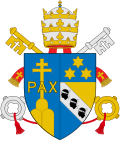| Quum memoranda Latin for 'On that memorable day' Papal brief of Pope Pius VII | |
|---|---|
 | |
| Signature date | 10 June 1809 |
| Subject | Excommunication of Emperor Napoleon |
| Number | 2 of 5 of the pontificate |
Quum memoranda (Latin, "on [that] memorable [day]...") was a papal brief issued by Pope Pius VII in 1809. It was a response to a decree issued by Emperor Napoleon, on 17 May 1809, which incorporated the remnants of the Papal States into the French Empire, during the Napoleonic Wars. The brief was published on 10 June, the day of the decree's proclamation in Rome, capital of the Papal States, with an excommunication of Napoleon (though not by name) and all those who had contributed to what the Holy See saw as a violation of its temporal power. [1]
Contents
French troops had already occupied Rome in February 1808, followed by the Marches, [2] and in April of that year a decree by Napoleon announced the annexation of the Church States, although without affecting the pope's power in the capital. In May 1809, however, two more decrees were published, with the first declaring that the "temporal pretensions of the Pope were irreconcilable with the safety, tranquility, and prosperity of the Empire". This was proclaimed by the French authorities in Rome, on 10 June 1809, thus ending the secular power of the already weakened Holy See. Pius, after some hesitancy, released the excommunication bull later in the same day, thanks to the insistence of his advisor Cardinal Pacca. By the following morning, [1] issues were already posted on the walls of the three major churches of Rome, Saint Mary Major, Saint John Lateran and Saint Peter. [3]
